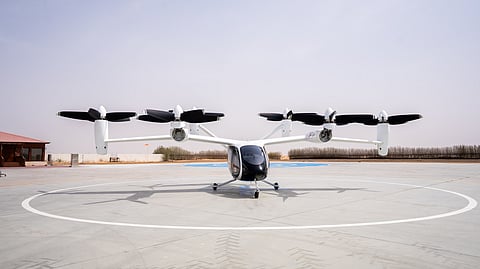Dubai air taxi: 10 things that make Joby’s aircraft the future of transportation
Starting 2026, eVTOLs will have a 160km range, 320km/h speed for 4 passengers

Dubai: With a flight range of up to 160 km and a maximum speed of 320 km/h, Joby aerial taxi can shorten a 45-minute car ride from Dubai International Airport to Palm Jumeirah to 12 minutes for four passengers, including the pilot.
What’s more? The air taxi is powered entirely by electricity, producing zero operating emissions, aligning with Dubai’s sustainability goals.
Its design includes six rotors and four battery packs, operating at significantly lower noise levels than traditional helicopters.
All this and more were unveiled after Joby Aviation – the US company developing electric air taxis for commercial passenger service – completed the first successful test flight of its aerial taxi at the Dubai Jetman Helipad in Margham, situated along the Dubai-Al Ain road.
Joby Aviation partnered with Dubai’s Roads and Transport Authority (RTA) to conduct the test run in Dubai on Monday. The aircraft has been undergoing two years of flight trials at the Edwards Air Force Base in the United States.
Joby completed its first such 'transition' flight in California in April. However, this is the first time the NYSE-listed start-up, which has raised more than $2 billion in funding from investors, including carmaker Toyota, has conducted the tests as part of a test flight campaign before commercial launch. Toyota is also Joby's manufacturing partner.
According to JoeBen Bevirt, Founder and CEO of Joby Aviation, Dubai serves as a launchpad for a global revolution in mobility. “Flying our aircraft here represents a pivotal step towards integrating Aerial Taxi services into the fabric of daily life around the world,” said Bevirt.
Here are the top 10 factors that make aerial taxis the future of transportation in Dubai:
Travel time
The aerial taxi will introduce a new premium service for residents and visitors to key destinations across the city. For example, a journey from Dubai International Airport to Palm Jumeirah is expected to take just 12 minutes, compared to 45 minutes by car.
The service is expected to be integrated with Dubai’s public transport ecosystem as well as individual mobility options such as e-scooters and bicycles.
According to the RTA, this would enable seamless multimodal travel and enhanced connectivity across the city.
Airport-adjacent operations
Aerial taxi station operations will be launched near Dubai International Airport, providing travellers with convenient access.
Vertiports for the air taxi
The vertical take-off and landing (VTOL) capability makes it ideally suited for urban environments, requiring minimal space for operation at specially developed vertiports. Dubai’s first flying taxi vertiport, Dubai International Vertiport (DXV), will be located near Dubai International Airport.
The first of four initial air taxi vertiports, developed by UK-based advanced air mobility infrastructure company Skyports, received design approval from the General Civil Aviation Authority (GCAA) in January this year.
Launch dates
The first commercial aerial taxi flight is scheduled for 2026, and aerial taxi station operations are set to be launched near Dubai International Airport, officials announced following the test flight.
Flight bookings
Those excited to experience Dubai's new aerial taxi service will be able to book their flights through a dedicated Joby app, which is set to launch ahead of the service's launch.
The initial operational route will connect Dubai International Airport (DXB) with Dubai Marina, with plans to extend services to key areas, including Downtown Dubai and Palm Jumeirah, in the future.
Cost of travel
The aim is to price the air taxi rides competitively, aligning with the cost of premium ride-hailing options similar to Uber Black (a premium ride service).
While specific fare details are yet to be announced, the company anticipates that fares will decrease as operations scale and the network becomes more efficient.
Expansion plans
Joby Aviation also intends to launch a fleet of multiple aircraft and is currently exploring opportunities to expand its flying taxi services to other emirates across the UAE, viewing Dubai as a crucial starting point for regional expansion.
Top features
The aircraft design itself features six rotors and four battery packs. With this, it can achieve a flight range of up to 160 km and a maximum speed of 320 km/h. The aircraft accommodates four passengers in addition to the pilot and can carry a payload of 450kg.
High-speed travel
The aircraft can reach a maximum speed of 320 km/h, significantly reducing travel times.
Test facilities
Dubai officials stated that they had reviewed the test facilities developed in collaboration with Shamal Holding. These facilities include a dedicated vertiport for aerial vehicles, a hangar equipped for flight monitoring and tracking of the Aerial Taxi, and electric charging facilities.
Sign up for the Daily Briefing
Get the latest news and updates straight to your inbox






